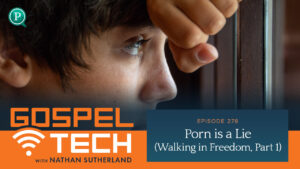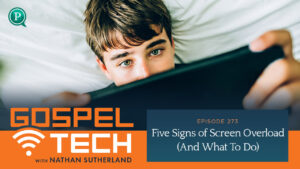Summer is approaching fast, and we need to assess our tech to ensure we’re ready for the fun, freedom, and digital changes that come with a few months outside of school.
To help prep our tech for summer we:
- Assess our tech
- Check our hedges
- Start the conversation
Transcription:
Nathan [00:00:07] Heavenly father, thank You for this chance to talk about technology. I ask for wisdom and speaking about the summer and how we can prepare our technology. Would this be applicable and encouraging and provide opportunities for families to get more time together, but also to use their tech together intentionally. I asked this in Jesus name. Amen.
Nathan [00:00:25] Hello, everyone, and welcome to the Gospel Tech podcast. My name is Nathan Sutherland and this podcast is dedicated to helping families love God and use tech. Today we’re talking about how can we prep our tech for summer? And specifically we’re talking about how do we make our tech safe for this summer? So a lot of school years coming to an end in Pennsylvania. They’re done in like ten days. Here in Washington state, we have all the way to the end of June, depending on the district you’re in. But the idea is still there. We’re prepping for summer. Let’s assess the rhythms that we’ve been in and the rhythms for going to and ask ourselves, is our tech safe? We will extend this conversation in the coming weeks, but today, really trying to keep it condensed one so it’s applicable and two, so it’s shareable. I know some of you have adapted your taste to my styles and I appreciate that because my brain works in a certain way. But I do want to make sure that this is accessible to a lot of people. So let’s jump right in. With no further ado, let’s get this conversation started.
Nathan [00:01:24] Welcome to the Gospel Tech podcast, A resource for parents who feel overwhelmed and outpaced as they raise healthy youth in a tech world. As an educator, parent and tech user, I want to equip parents with the tools, resources and confidence they need to raise kids who love God and use tech.
Nathan [00:01:47] Thank you to everyone who’s made this podcast possible. Thank you for listening, for sharing, for liking and subscribing. And thank you for going to GospelTech.net and donating. We are donor supported, we’re a nonprofit and that allows us to continue to do this work. So thank you so much. In this conversation today, we’re talking about how do we make our tech safe for summer? The first thing we got to do is assess our tech. Just how much have we got? Look at your house. Get out a piece of paper, Get your kids around you. If they’re older than the age of six, they can help. Hey, what tech do we even have in this house? You might have smart TVs, you might have smart DVD players and DVRs, which gives smart capabilities to other TVs and screens. You might have smart phones, laptops, tablets, e-readers. You might have old dead iPhones and Android devices lying around your house. You may have steam decks and Xboxes and PlayStations and gaming consoles of any variety and age. You could have anything out there, including even like raspberry pies, little devices that can be programed in a lot of different ways. Those are also Internet accessible, depending on how old they are. You just need a list. Just what do we have as a family? What do we got in old boxes in the garage? What do we have sitting in the couch in the Ottomans or like just what’s around our home? Let’s assess our technology, because only then can we actually ask ourselves, is it safe? The safest form of technology will be tool tech. It’s going to help us create. It’s not going to have any apps, it’s not going to have any browser. So let’s look at a smart TV, for example. A smart TV is technically tool tech, although almost all of what it engages is drool tech. So kind of confusing there, but it’s tool tech. It doesn’t have notifications, it doesn’t have algorithms in itself. But when it’s a smart TV, it does have a browser, it does have apps. And so that’s two out of three. The third is can it be held accountable? Yes, by your network. You get something like a Gryphon router or a Bark home, which we’ll talk about just in a minute. And it is now beholden to your Internet. It doesn’t have a cell service on a tablet. So a smart TV would be an example of one to think through. Do we have protections in place compared to an old smartphone? It’s going to have apps. It’s not going to have Internet, but it’s going to have accountability through your Wi-Fi. If you have that. It has a browser and it is mostly drool tech, right? The phone itself is designed to send you notifications and to deliver apps. So unlike a TV, which simply is the portal for your Internet access, the phone is generally trying to distract you with that because it’s premised around getting more apps, more games, more social media, more of whatever helps make that company money.
Nathan [00:04:17] So we want to make sure we’ve thought through that the safest form of technology in your house would be something like a Gabb phone. So this is a phone that does not do anything other than tool tech. It makes calls, receives them. It does not have an app store, it does not have a browser and it is highly accountable. So that would be our best case scenario. We just go through. Is it safe? That’s what we want to know. After we know if it’s safe, we want to know if it fits with our families, I guess the bigger picture is, is it useful? It’s wonderful to have good tech. It’s wonderful to have safe tech. But at the end of the day, we don’t want to be adding things that aren’t productive for us. So look at your technology, all of it you’ve written down and you’ve assessed its safety levels and say in this season of life, is this tech useful? First, is this useful for our family based on what we’re going to be doing with our family expectations, our priorities, the space that we have and what we’re emphasizing, or as Andy Crouch puts it in the Tech Wise Family, is does the technology reflect your values? What does your furniture point at? Right? That idea, is that lining up? And that’s the question that Anna and I, when reflected on, we’re like, you know what, we can still enjoy our shows, but we don’t need a dedicated TV for us. We cut that cord, we pay some Internet subscription stuff and we watch shows on our laptop, at which point the shows go away. We like that rhythm. Our kids still watch shows, they enjoy it. We still do movie nights, all that stuff. But for us, that question got us and that’s what we’re asking. When you see that list and go what of this is necessary for what our family is doing? And what of it is just kind of because we’ve accumulated stuff? Do we need to give it away? Do we need to recycle it? Can we sell it? Like what needs to happen with this technology? The second part of that is, is this tech a good choice for our children that are at with our trust? You might have a wide range of kids. I’ve talked to families where they’ve got 20 year olds and they’ve got eight year olds in the same house. That’s different, right? That’s going to change the level that eight year old is growing up in a 20 year old’s house now. And the question is, what of this technology is a good fit for our family and what of it is good fit for the trust we have? So is my child trustworthy? Not do I trust them, but have they earned it? We’re looking a little bit at like the Luke 16 that we’re being faithful in the little things. So being faithful in our schoolwork and faithful in our chores and faithful with our attitude and faithful with our open conversation. And we know that this child comes to me and approaches me when they make mistakes, they’re quick to repent. And when I correct them, they receive correction and discipline. Amazing. That’s going to be a higher level of trust. Then let’s say a child who’s been known to sneak around in order to turn into a bit of a tech ninja is Chris McKenna’s from Protect Young Eyes this idea there and already struggles with accountability and making good decisions in that kind of digital freedom. In that case, we want to make sure we’re being very careful with things like phones that can slip into bedrooms and e-readers that have access to the Internet. So just be mindful of that. Where is our trust about our family? Because our amount of technology, proximity to technology and hedges around technology all should reflect the answer to that question. And then when we’ve looked at that now, we now know how much tech we have, if it’s safe and how it fits with our family’s goals. When we look at our tech, sometimes we just fall into a lot of tech, and other times now we have a lot of tech. We’re being really intentional about how we address it, engage it, use it while we’re training up our kids. Awesome in a digital space to be the ones using tech, not let tech use them. Super cool. Just make sure that as you prep for summer you’ve thought that out. Where does the school 1 to 1 device go? Sometimes districts have you hand it back in. Sometimes your child might be doing work over the summer. Let’s be thoughtful. What are we doing with this? And I don’t think I even addressed in this, but and maybe it’ll be in this next one, but we should make sure we have locations where a tech is actually a persistent third point. All right. But spoiler. Steal my own thunder. So then let’s look at the second point.
Nathan [00:08:08] The second point is, let’s check our hedges. We know what tech we have. We know if it’s safe. We know if it’s a good fit for the season of life. Check our hedges. We need to hedge around our network, a hedge around our devices, and a hedge around our family. The network means the thing that gives you wireless Internet at home. If you have Internet without cell service, you’ve got a network, something like a Gryphon router or a Bark home. And the reason I say, or as some of you love your wireless Internet router or you just don’t care and you have your Xfinity whatever and it’s cool and it works fine. Bark can plug straight into that. It’s the Bark home compared to the Bark software compared to the Bark phone. It’s a little confusing on the marketing. I get that. But just know the Bark Home is a little box like Yay big and it plugs into your router and it provides you the ability to block certain websites and set internet for times of day and know where people are going online and also comes embedded with Bark’s monitoring of social media and conversational activities, search history, that kind of thing. So that’s a wonderful resource. Gryphon is a little more robust on the home protection, and it allows you to set parameters by device. So if you have three kids and two adults in your home, it lets you determine each device. There’s work devices, there’s personal devices, there’s guest devices. So it does take a little more to set up. But I like that for a network hedge. It’s what I personally use. It’s what is this being streamed from is a Gryphon AX router. So I’ve liked it and it’s been awesome. It defaults everything to safe mode and just makes it that much easier to have kids in a world of Internet. So make sure your hedge around your network is there. The devices need some kind of accountability. We should never be the only one seeing what’s happening online. So as you look to the summer when a phone leaves into the cul de sac, when your child goes to a friend’s house, when people come over to sleepover, do those devices have accountability? If that device connects to your network, so long as your network is covered, then your good that would be like someone brings over a Nintendo switch and wants to play games online. Okay, they can do that if they have an Xbox. Great. It’s still under your network. If it comes with the smartphone and it’s on cell service or hotspot. Now devices are getting around your network. They need their own protection, which means either the device goes away. I have had pushback on this from young people. And when I ask why does that child need a smartphone when they’re hanging out with you, their answer was they won’t come over if I tell them their phone can’t be on them. Let’s give a moment of pause for that, that this child will choose their smartphone over you. That’s troubling. That’s really sad. I’m not denying that that’s not real. I think we want to stop and pray and talk into that conversation when it comes between this child is going to have a friend in real life or this child gets their phone. This child is opting for a phone, one that’s probably not a friend. Two, that’s probably not the best for them. There’s probably something better. What we are modeling as parents, though, is what does it look like to make intentional time to use those fun devices and be connected and also intentional time to be present and then model that for our friends. And yet sometimes we have to make hard calls. So I’m just going to leave it at that. Please do. You have a network had you have a device hedge. Bark is a great device hedge. Covenant Eyes is another great device hedge that goes on laptops, it goes on phones. Again, iPhones are built around privacy. They can be difficult to hold accountable. So Android devices, Google phones, it’s Google Pixel or Samsung devices provide you a much broader range of accountability, good for adults and for young people.
Nathan [00:11:47] And then third, and finally, around your family, you need to have talked about this. Please don’t just listen to this podcast or watch this video and then go look. Well, I’m going to set up all these things. My kid’s going to have no idea why I’m changing the parameters. They’re going to assume that you assume they’re making mistakes. That’s not the goal. The goal is to know what’s happening. If there are mistakes going on online, you want to know about that. If there are not any mistakes happening online, you want to know about that, too. That’s great. They have different outcomes, but we want to know both. So the idea here is we’re going to build a hedge around our family through loving conversation, setting up biblical standards for how we engage technology in the world of the Internet, but also setting up biblical standard for where we look for our hope to make sure that tech is staying where it’s supposed to. I heard a stat this week that 89% of our time on our smartphones is user generated, meaning it no longer comes from notifications and from pings from your phone. It’s, we’ve been trained to need our phone and to feel good around it and therefore will choose our phone over a friend for example. We will choose to go to our phone nine out of ten times because of something happening in our hearts, which means it’s going to take some intentional retraining. By the way, when phones first came out, that was not the case that we were somehow running after phones. We didn’t even know why we needed them back then. Now we’ve been convinced they’re very useful, they’re very valuable, and they’re a net gain. Great. Make sure that they’re staying where you put them and that we put them where they need to go, that we’re keeping them a proper amount of space away from us. The family tech framework will help. So GospelTechworkshop.com is where you can go for the online version. There’s a PDF workbook that walks you through how to talk about Tech, the Gospel Foundation tool and drool reset. How do we know when there’s problems and then how do we walk it out? Making the tech framework. It ends up being somewhere in the range of 6 to 12 sentences is what you’ll end up with 6 to 12 little sentences that make basically your family’s framework for dealing with tech. And when something goes off, you either assess, Hey, does this framework no longer represent what’s valuable, important and safe for us? Or is that behavior no longer fitting within our framework, right? That the conversation. It’s not just these are the rules and they’re the truth forever. Sometimes stuff changes. In my life, video games went away. It no longer lines up with what’s best for me. Okay, but maybe sometimes we add something, right? Video games have been added for my children and playing with friends. They play games at friends houses. There’s a very specific set of parameters and there’s reasons why we don’t bring them into our house, both because of dad and otherwise, it’s not a net gain inside our home right now in this season. That’s what you want to be able to talk about. The framework helps you do that.
Nathan [00:14:29] Finally, we’re going to start the conversation in the framework, and I want to walk you through what that looks like. You’re going to talk about ground rules. My favorite ground rule is that these rules apply to everybody, which means kid smartphone rules apply to parents. And no you don’t just give back. Well, I’m an adult. I get to do stuff. There might be a time and a place, for example, some work stuff that you spend more time in front of a screen, for example, than kids having your kids understand that, Hey, this is how mom or dad works. This is tool tech. Here’s what I do to make sure I don’t get distracted by YouTube. I don’t get distracted by Twitter. Here’s what I’m doing as an adult and this is what I want you to know how to do when you step out into that world. That’s why we’re doing this well. Great. Have that conversation. Ground rules help. Then you talk about the time and the place. Time is both when you’re going to use it for how long and how often. This is that idea that behavioral psychology is us performing our brains based on repeated habits in terms of technology. That’s from repeated triggers. It tells us to do something and we’re more likely to do it. We’re more likely to nine out of ten times choose to do it on our own, because now we’re convinced it’s important we’ve practiced it enough. Okay. With time, though, if I use my phone once for 20 minutes versus I use it 10 seconds, 20 different times, well, that’s. 20 different reps versus one rep. We want that. We want to it’s okay to go to your phone for 20 minutes as long as you’re using it intentionally and you walk away when the time is done. That’s awesome. That’s healthy tech. Go ahead and use drool tech like that. Use tool tech like that. Don’t just run after it every single time you feel a little bored or you feel a little confused or anxious. This is something I do. By the way, I’ve mentioned this before with my news apps. I had to delete them. They had to go and I can check news through the browser, but turns out I don’t as much. In fact, over the last two weeks I found myself picking up my phone and be like, Oh yeah, it doesn’t have it. Well, I guess there’s nothing for me to do here. That’s what we’re trying to talk about with our kids. The place. That’s the time. The place is where we’re going. These are public spaces, not in the bedroom. Then we’re talking about content. There’s a lineup with Philippians 4:8. Does it line up with producing Fruit of the Spirit? Does it line up with focusing our minds on the things of the Spirit as we’re encouraged to do in Romans 8:5? And then we talk about our priorities. Where are we putting our money or putting our time and where are we dedicating space to this stuff? It has to be a priority in your house. If you’re going to have it. It can’t be an afterthought. It can’t just be because everyone in the neighborhood has got one. Whatever the devices, whatever the tech is, once you’ve assessed it, even if it’s pretty safe, We want to be intentional with this stuff. Even just to stop the creep, even if it’s the best tool tech in the world, if it’s a Gabb phone and it’s completely locked down, you’re not going to make mistakes on this device. I would put that in the category, something like email, and yet we can misuse email. I have personally misused email to try to find my purpose by being busy with work and having that identify me and make me feel good. We want to put boundaries around that. I need time and days that I go and check my email and times I don’t. So I have those. You’re going to want to do it too, as you look into summer.
Nathan [00:17:32] And last one is the safety. Make sure you’ve talked to your children about strangers, bullies, pornography and what the expectation is when they step into that digital cul de sac. That space where all their friends are and they’re going to have a good time, they’re going to learn really neat stuff to remember that it is still the digital cul de sac. It still is next to a highway in a federal penitentiary and the red light district at midnight. They need to go with some accountability. They need to go in relationship and they need to go when they’re able to be trusted and it’s a healthy time of life to trust them both age wise, emotional, develop wise and just circumstantially what’s going on in their life and their family, etc.. So that is what we’re looking at for the summer. This summer, as you look towards using your technology, let’s look at first how much we got, assess it, is it safe? And then finally, let’s check our hedges. When we look at what is being built up around our family, do we have a hedge around our network, around our devices and around our family? And then we walk through what that can look like, Those six areas again, Gospeltechworkshop.com. You can find the online workshop for that. You can print out the pages that you’d like your children to do. Children six and over can participate in that. They understand the bigger picture of safety, of love, of holding a hand across the street, right walking through a parking lot. This is digital hand-holding. It’s not that I don’t like you. It’s not that I’m mad. It’s that this is a dangerous space. We’re not in control of all the variables, so let’s be intentional about how we use it and when we use it and why we use it.
Nathan [00:19:00] So I hope this is encouraging and helpful. I hope that you can use it to apply to your own technology in a meaningful way in the next couple of weeks, and you’ll share it with people who might have questions about their own technology or want to think intentionally about their tech, because that is what we’re hoping to do here. Empower parents to raise up kids who love God and use tech. And I hope you’ll join us next week as we continue this conversation about how we can love God and use tech.
Follow this podcast:







